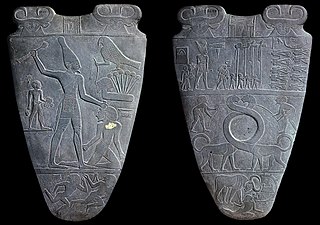The Old Kingdom is marred in mystery and the unknown. Spanning from the 3rd dynasty to the 6th dynasty, it encompasses the Pyramid Age and the unification of the Two Lands (twy). It is the Old Kingdom that has fueled our imaginations and hearts from the pyramids and Sphinx of Giza to the the Step Pyramid of Netjerikhet (Djoser). It is a timeless age that evokes emotion and awe. Through the next few weeks, we will discuss the rise and fall of the Old Kingdom, its kings and nobility, the Giza Plateau, and finally why, in fact, did the Old Kingdom fall. Was it the unjust acts of weak rulers or natural consequences and disasters that did seem to plague the land at the end of the sixth dynasty or was it a failed economy?
 |
| The Narmer Palette Wikipedia images |
Before pharaohs, dynasties and Upper and Lower Egypt really, there were three major cultures that surrounded the Nile so if you are really interested in anthropology or pre-history, then you may want to delve further into the cultures but the three cultures are the Gerzian, Amratian and the Predyastic cultures of Upper Egypt. At the same time that these cultures were rising there was another culture rising in the delta region of Egypt known as the Madi Buto culture. These cultures form the springboard from which came Upper and Lower Egypt which then led to the unification of Egypt. Whether these cultures assimilated peacefully or militarily is a matter of debate. The ephemeral figure called Narmer who may have come from a figure called the Scorpion King, is responsible for the unification of Upper and Lower Egypt. How do we know this? The Narmer Palette. In 1898, archaeologists James Quibell and Fredrick Green found this Narmer Palette which has quite a tale. On one side of the palette, one can clearly see a man smiting a enemy from the Delta region while he is holding his head. There is also a figure of a bird and two faces of a cow. The palette also shows Narmer trampling his enemies under his feet all the while wearing the Hedjet or the white crown of Upper Egypt.
 |
| Battlefield Palette |
On the other side of the palette, Narmer is wearing the Deshret or the red crown of Lower Egypt. He is leading a procession with figures of decapitated men preceding him. In the cross or middle section we see two serpents which is probably an idea from Mesopotamia. Again, we see the cows on the top of this side of the palette as well. But how do we know that this man, Narmer, is on the palette? If one looks at the top of the palette (wearing the hedjet crown), we see "nrmr," which means fighting catfish, written in a serekh. What is a serekh? It is a façade of a palace symbolising royalty or kingship. But what do we make of the cows found at the top of the palette though? According to Rutgers University, the cows are representations of the bovine goddess of Bat instead of the more infamous goddess Hathor. The bovine goddess Bat is a lesser known deity of the seventh nome of Egypt symbolising femininity but was later consumed by the goddess Hathor much in a similar way that Osiris consumed the god of Khentiamentiu in a previous blog.
The reasons to believe that Upper and Lower Egypt were united through violence however is because not only of the Narmer Palette but the what is known as the Battlefield Palette or Vulture's palette. The Battlefield Palette is a rather interesting piece. It is a shard found in the town of Nekhen by the same men James Quibell and Fredrick Green in 1900. This palette is rather a mystery because it seems to depict several bound prisoners sacrificed to some animals. What is rather odd however is the absence of a ruler or conquerer. It simply shows a lion eating a prisoner and vultures pecking at the heads of other prisoners. According to the British Museum, the lion may actually depict the king but nothing more can really be surmised. The British Museum does date this to the time of Narmer which could mean that this was another example of his victory against Lower Egypt which ultimately led to his unification of the Upper and Lower Egypt.
 |
| Ramesses II killing his enemies from blog History Interrupted |
Why spend so much time on these two palettes though, you ask? Good question! These palettes tell rather interesting story. They record the unification of Egypt by a figure called Narmer through a bloody and violent campaign. In addition to this unification, The Narmer Palette also depicts the pharaoh in a pose that we shall see time and time again throughout funerary art in which the pharoah will decapitate his enemies heads. It is an image that exhibits power and establishing him as the sole ruler of Egypt striking fear into the hearts of those who dare protest his reign and authority. They are rather telling pieces of propaganda if the latter palette depicts the lion as the king, Narmer.
References
http://www.britishmuseum.org/research/collection_online/collection_object_details.aspx?objectId=116965&partId=1
http://egypt-grammar.rutgers.edu/Artifacts/Narmer%20Palette.pdf



No comments:
Post a Comment